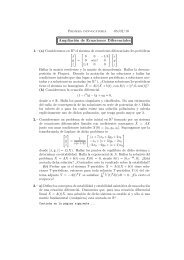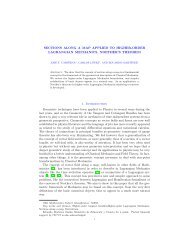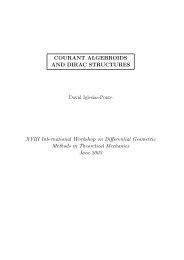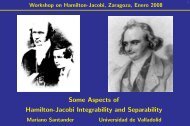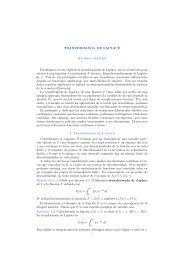PARALLEL TRANSPORT AND DECOUPLING 1. Introduction One of ...
PARALLEL TRANSPORT AND DECOUPLING 1. Introduction One of ...
PARALLEL TRANSPORT AND DECOUPLING 1. Introduction One of ...
You also want an ePaper? Increase the reach of your titles
YUMPU automatically turns print PDFs into web optimized ePapers that Google loves.
<strong>PARALLEL</strong> <strong>TRANSPORT</strong> <strong>AND</strong> <strong>DECOUPLING</strong>EDUARDO MARTÍNEZAbstract. The problem <strong>of</strong> decoupling second-order differential equations bycoordinate transformations is studied in terms <strong>of</strong> parallel distributions withrespect to the linear connection associated to that differential equation.<strong>1.</strong> <strong>Introduction</strong><strong>One</strong> <strong>of</strong> the most fruitful tools in the analysis <strong>of</strong> qualitative properties <strong>of</strong> system<strong>of</strong> second-order differential equations (sode) during the last decades has been thenonlinear connection [2] associated to such sode and the corresponding linear connection[5], also known as Berwald connection. For instance, it is very useful in theanalysis <strong>of</strong> the Inverse Problem <strong>of</strong> Lagrangian Mechanics [11], it is fundamental tocharacterize those sodes which can be transformed to linear sodes by a coordinatetransformation [9, 5] and also to characterize those systems <strong>of</strong> second-orderdifferential equations which decouples under a coordinate transformation in twosubsystems <strong>of</strong> independent second-order differential equations [8, 1], to mention afew problems in which it has been successfully applied.In [6] Crampin provides a geometrical interpretation <strong>of</strong> the parallel transportmap associated to the linear connection D along horizontal and vertical curves,which moreover characterizes such connection. The interpretation <strong>of</strong> the paralleltransport along integral curves <strong>of</strong> a projectable horizontal vectorfield is given interms <strong>of</strong> Lie transport under the flow <strong>of</strong> this vectorfield. This fact strongly suggeststhat a parallel distribution must satisfy some property <strong>of</strong> invariance under someflows, and therefore there should be a connection with the integrability <strong>of</strong> suchdistribution.The aim <strong>of</strong> this paper is to explore this relation and to apply this results to theproblem <strong>of</strong> decoupling <strong>of</strong> second-order differential equations, providing a simplifiedalternative derivation <strong>of</strong> the results in [1]. In this sense many <strong>of</strong> the results in thispaper are already in the literature, and its merit is mainly to provide simpler andmore readable pro<strong>of</strong>s <strong>of</strong> such results.The paper is organized as follows. In section 2 the notation and preliminaryresults that will be needed in the rest <strong>of</strong> the paper are introduced. In section 3 werecall the construction <strong>of</strong> the linear connection associated to the nonlinear connectiondefined by a sode. In section 4 we recall Crampin’s interpretation <strong>of</strong> paralleltransport for such connection, and in section 5 we show that a parallel subbundleis necessarily integrable. In section 6 we characterize those sodes which can be2000 Mathematics Subject Classification. 34A26,34C35,53B05.Key words and phrases. Second-order differential equations, linear connections, nonlinear connections,parallel transport, decoupling <strong>of</strong> differential equations.I would like to thank to Tom Mestadg and Willy Sarlet for many illuminating discussions.1
2 EDUARDO MARTÍNEZdecoupled by a coordinate change and finally in section 7 the case <strong>of</strong> a completedecoupling into scalar second-order differential equations is analyzed.2. PreliminariesLet π : E → R be a fibre bundle with fibre dimension n, and let π 1 : J 1 π → Rbe its first jet bundle. The vertical bundle with respect to the bundle projectionπ is denoted by Ver(π), whereas the vertical bundle with respect to the projectionπ 10 : J 1 π → E will be denoted by Ver(π 10 ), i.e. Ver(π) = Ker(T π) and Ver(π 10 ) =Ker(T π 10 ).We consider the canonical coordinate t on R and natural bundle coordinates(t, x i ) on E and (t, x i , v i ) on J 1 π. Any time-preserving coordinate transformation(t, x i ) → (t, ¯x i ), where ¯x i = ¯x i (t, x) leads to the following formulas for thecoordinate transformation on J 1 π,t = t, ¯x i = ¯x i (t, x), ¯v i = ∂¯xi∂t + ∂¯xi∂x j vj ,from where we can clearly see the affine character <strong>of</strong> the bundle J 1 π, whoseassociated vector bundle is Ver(π). The fibre over an element m ∈ E can beconsidered as an affine hyperplane <strong>of</strong> the tangent space at m, and therefore wehave the following sequence <strong>of</strong> vector spaces 0 → Ver(π) m → T m E → R → 0, wherethe map in the right consists in taking the t-component v ↦→ 〈dt, v〉. Elements <strong>of</strong>J 1 π can be identified with tangent vectors to E which projects onto ∂/∂t. Thisidentification may be regarded as defining a map T : J 1 π → T E, given by T (jt 1 γ) =˙γ(t). We therefore have the following commutative diagram <strong>of</strong> vector bundles overE, where the row is an exact sequence,0 Ver(π)i T Ej E × R 0.T(π 10,1) J 1 πA section <strong>of</strong> π ∗ 10(T E) is said to be a vectorfield along π 10 . Alternatively, it canbe considered as a map X : J 1 π → T E such that τ E ◦X = π 10 , that is X(p) ∈ T m Efor every p ∈ (J 1 π) m . The section associated to this map is just p ↦→ (p, X(p)).For instance, the map T above can be considered in a natural way as a vector fieldalong π 10 , called the total time derivative, and which in coordinates readsT = ∂ ∂t + ∂vi∂x i .Any vectorfield Y on E gives rise to a vectorfield along π 10 by composition withthe projection π 10 . Explicitly the associated section <strong>of</strong> the pullback bundle is p ↦→(p, Y (m)) where m = π 10 (p). The vectorfields along π 10 which arise in this way arecalled basic.A sode on E is a vectorfield Γ ∈ X(J 1 π) which projects onto T . In coordinatesit is <strong>of</strong> the formΓ = ∂ ∂t + ∂vi∂x i + f i ∂∂v iwhere f i = f i (t, x j , v j ). Therefore the system <strong>of</strong> differential equations for the integralcurves <strong>of</strong> Γ is the non-autonomous second-order system <strong>of</strong> differential equations,
<strong>PARALLEL</strong> <strong>TRANSPORT</strong> <strong>AND</strong> <strong>DECOUPLING</strong> 3written as a first order system,ẋ i = v i˙v i = f i (t, x, v).or in second-order form ẍ i = f i (t, x, ẋ).After a time-dependent coordinate transformation the coordinate expression forΓ becomesΓ = ∂ ∂t + ∂¯vi ∂ȳ i + ¯f i ∂∂¯v iwhere¯f i = ∂¯xi∂x j f j +∂2¯x i∂x j ∂x k vj v k + 2 ∂2¯x i∂x j ∂t vj + ∂2¯x i∂t 2 .a formula which remind us how the fiber coordinates v i enter into the transformationlaw.The problem we are faced to is to find a coordinate transformation such thatthe system <strong>of</strong> second-order differential equations is transformed to the so-calledsubmersive form { ẍi = f i (t, x j , ẋ j )i, j = 1, . . . , dẍ A = f A (t, x j , x B , ẋ j , ẋ B )A, B = d + 1, . . . , nor to a separated or decoupled form{ ẍi = f i (t, x j , ẋ j ) i, j = 1, . . . , dẍ A = f A (t, x B , ẋ B ) A, B = d + 1, . . . , n.3. The linear connection associated to a sodeThe fibration π 10 : J 1 π → E determines an exact sequence <strong>of</strong> vector bundles overJ 1 π0 π ∗ 10 Ver(π)ξ V T (J 1 π)j π ∗ 10(T E) 0 ,where ξ V is the vertical lifting map (given by ξ V (p, v) = d dt | t=0(p + tv)) and j isthe projection j(V p ) = (p, T π 10 (V p )).A (nonlinear) connection on J 1 π is a splitting <strong>of</strong> such sequence, that is, a linearbundle map h: π10(T ∗ E) → T (J 1 π) such that j ◦ h = id. In other words, it isequivalent to a vector subbundle Hor(π 10 ) <strong>of</strong> T (J 1 π) which is complementary tothe vertical subbundle Ver(π 10 ), and is therefore called horizontal.A sode Γ on J 1 π determines a connection on J 1 π. The projector onto thehorizontal bundle is given in terms <strong>of</strong> the vertical endomorphism S = (dx i −v i dt)⊗(∂/∂v i ) by the formulaP H = 1 2 (I + Γ ⊗ dt − L ΓS) .The coordinate expressions for a basis {H 0 , H 1 , . . . , H n } <strong>of</strong> horizontal vector fieldsareH 0 = ∂ ∂t − ∂Γj 0∂v j and H i = ∂∂x i − ∂Γj i∂v jwhereΓ j 0 = −f i + 1 i∂fvj2 ∂v j and Γ j i = −1 ∂f j2 ∂v i .Note that, in particular, the sode Γ is itself horizontal; it is the horizontal lift<strong>of</strong> the canonical vectorfield T .
4 EDUARDO MARTÍNEZBy a kind <strong>of</strong> linearization <strong>of</strong> the given nonlinear connection, we can define a linearconnection on the pullback bundle pr 1 : π ∗ 10T E → J 1 π. The associated covariantderivative is given byD Z X = κ([P H Z, Y V ]) + j([P V Z, Y H ]) + P H (Z)〈Y, dt〉T ,where Z is a vectorfield on J 1 π, Y is a vectorfield along π 10 (i.e. a section <strong>of</strong>π10T ∗ E), P H and P V are the horizontal and vertical projectors <strong>of</strong> the nonlinearconnection, Y H and Y V are the horizontal and vertical lifting <strong>of</strong> Y , and κ is theconnection map κ: T (J 1 π) → π10(Ver(π)), ∗ defined by the relation ξ V ◦ κ = P V .See [5, 4] for the details.The curvature <strong>of</strong> this connection was also studied in [5]. In particular, most <strong>of</strong>the components <strong>of</strong> the curvature tensor are determined in terms <strong>of</strong> the so calledJacobi endomorphism, Φ defined byΦ(X) = R(T , X),where R is the curvature <strong>of</strong> the nonlinear connection. Its coordinate expression isΦ = Φ i j (dxj − v j dt) ⊗ ∂∂qwithiΦ i j = − ∂f i∂x j − Γi kΓ k j − Γ(Γ i j).We remark that in general, for any connection on J 1 π, the horizontal lift <strong>of</strong> T isa sode on J 1 π, but it is to be noticed that the connection defined by this sode isnot the original one. This is the case only when the connection is a sode-connectionas above. Notice also that not every connection is the sode-connection for somesode.Proposition. A linear connection on π ∗ 10(T E) is the linear connection defined bysode if and only if it is torsionless, i.e.D X H Y − D Y H X = [X, Y ]for every pair <strong>of</strong> basic vectorfields X, Y ∈ X(E).The torsionless condition can be equivalently written in the form [X H , Y V ] −[Y H , X V ] = [X, Y ] V for every pair <strong>of</strong> basic vectorfields X, Y .In the local base {Γ, H i , V i } <strong>of</strong> vectorfields in J 1 π, where V i = ∂/∂v i , and thelocal base {T , ∂/∂x i } <strong>of</strong> vect<strong>of</strong>ields along π 10 the linear connection is determinedby( ) ∂D Vi∂x j = 0, D Vi T = ∂∂x i ,D Hi( ∂∂x j )= ∂Γk i∂v j∂∂x k , D H iT = 0,( ) ∂D Γ∂x j = Γ k ∂j∂x k , D ΓT = 0.In particular, from this expressions it is clear that D restricts to a connection onπ ∗ 10(Ver(π)): if Y is vertical over R, then the expression <strong>of</strong> the covariant derivativesimplifies toD Z X = κ([P H Z, Y V ]) + j([P V Z, Y H ]).
<strong>PARALLEL</strong> <strong>TRANSPORT</strong> <strong>AND</strong> <strong>DECOUPLING</strong> 5In what follows, to simplify as much as possible, we will consider the restriction <strong>of</strong>the connection to π ∗ 10(Ver(π)). Therefore, we will consider only vertical vectorfieldsalong π 10 .4. Parallel transportThe parallel transport map associated to the linear connection defined abovewas interpreted in the case <strong>of</strong> the autonomous formalism by Crampin in [6], andextended to the non-autonomous case in [10]. In this section this interpretation ispresented (in a slightly different way).Let X be a vector field on E and X H ∈ X(J 1 π) its horizontal lift with respectto the given connection. Denote by ϕ t the flow <strong>of</strong> X and by φ t the flow <strong>of</strong> X H .When the connection is linear, then φ t is a linear map in the tangent bundle T E,which is but the parallel transport map along the integral curves <strong>of</strong> X. Whenthe connection is nonlinear, we can linearize the flow obtaining a linear bundlemap Ψ t : π10(Ver(π)) ∗ → π10(Ver(π)) ∗ over φ t as follows. We take p ∈ J 1 π andv ∈ Ver(π), over the same point m ∈ E, so that (p, v) ∈ π10(Ver(π)). ∗ Then weconsider the linearization z = d ds φ t(p + sv) ∣ s=0. This is a vector at the point φ t (p)which is vertical, since X H is projectable and thus π 10 ◦ φ t = ϕ t ◦ π 10 . Therefore,there exists a vector P t (p, v) ∈ Ver(π) ϕs(m) whose vertical lifting to the pointφ t (p) is the above vector z, i.e. z = ξ V (φ t (p), P t (p, v)). Then we have the mapΨ t (p, v) = (φ t (p), P t (p, v)), which is the parallel transport map along the flow <strong>of</strong>X H (and hence along horizontal curves).In other words, if we consider the inverse κ: Ver(π 10 ) → π10(Ver(π)) ∗ <strong>of</strong> thevertical isomorphism ξ V : π10(Ver(π)) ∗ → Ver(π 10 ) ⊂ T (J 1 π), then the map Ψ t isdefined byΨ t = κ ◦ T φ t ◦ ξ V .Therefore, it follows that for every vectorfield Y ∈ X(E) vertical over R, we haveD X H Y = d dt (Ψ t ◦ Y ◦ φ t ) ∣ ∣t=0,which is equivalent to the relation D X H Y = κ([X H , Y V ]).For parallel transport along vertical curves we can prescribe a complete parallelismrule as follows. Let γ : [a, b] → J 1 π be a curve in the fibre π10 −1 (m), i.e.π 10 (γ(t)) = m, and let p i = γ(a) and p f = γ(b) the endpoints <strong>of</strong> the curve. We takean element <strong>of</strong> our bundle z ∈ π10(Ver(π)) ∗ at the initial point p i , that is z = (p i , v)for some v ∈ Ver(π) m . Then the parallel transport <strong>of</strong> z from p i to p f along thecurve γ is Pp γ i,p f(p i , v) = (p f , v). It is clear that parallel transport is independent<strong>of</strong> the curve γ that joins the point p i and p f as long as this curve is vertical, and itis in this sense that we speak about complete parallelism.5. Parallel distributions are integrableThe relation between parallel transport and Lie transport that we have seen inthe last section, suggests that there must be some relation between the propertiesfor a distribution <strong>of</strong> being parallel and being invariant under Lie transport by theflows in the distribution, which is known to be equivalent to the integrability <strong>of</strong> thedistribution. In the case we are considering (the case <strong>of</strong> the sode-connection) withthe help <strong>of</strong> the torsion-free condition we can see that parallel distributions alongπ 10 are integrable. The precise meaning <strong>of</strong> this terminology is as follows.
6 EDUARDO MARTÍNEZBy a distribution along π 10 we mean a subbundle D <strong>of</strong> π ∗ 10(T E). A distributionalong π 10 is said to be basic if there exists a distribution E on E such that D =E ◦ π 10 , that is, D v = E π10(v) for every v ∈ J 1 π. A distribution D along π 10 is saidto be integrable if it is basic D = E ◦ π 10 and the distribution E is integrable.On the other hand we will say that a distribution D along π 10 is parallel if it isinvariant under parallel transport P γ D ⊂ D for every curve γ in J 1 π. It is easy tosee that D is parallel if and only if it is invariant by covariant differentiation, i.e.D W D ⊂ D for all W ∈ X(J 1 π).As we mentioned before, we only consider the subbundle π ∗ 10(Ver(π)) ⊂ π ∗ 10(T E),and therefore in the rest <strong>of</strong> the paper we consider only R-vertical distributions.Theorem. If a distribution along π 10 is parallel then it is integrable.Pro<strong>of</strong>. If D is invariant by parallel transport over vertical curves then it is a basicdistribution. Indeed, parallel transport along vertical curves is (p i , z) ↦→ (p f , z),and therefore, a distribution D is parallel along vertical curves iff D p depends onlyon the point m = π 10 (p). Defining E m = D 0m then we have that D p = E m .Moreover, since the connection is torsionless we have that D X H Y − D Y H X =[X, Y ] for all X, Y ∈ X(E). Therefore if X, Y are vectorfields in the distribution Ewe have that D X H Y and D X H Y are in E, and hence [X, Y ] is also in E. Thus E isinvolutive and therefore integrable.□It is to be noticed that from the properties <strong>of</strong> the linear connection D, one cansee that it is enough to impose the invariance condition D Z D ⊂ D for π 10 -verticalvector fields Z and for Z = Γ, being the invariance under D Z for Z a horizontalvectorfield a consequence <strong>of</strong> those.It would be nice to understand in more detail the implications <strong>of</strong> the torsionfreecondition in what respect to parallel transport along horizontal curves.6. Submersive sodesIn this section we will use the results in the last section in order to characterizethose systems <strong>of</strong> second-order differential equations that can be decoupled. The followingis an adaptation to the non-autonomous case <strong>of</strong> the definition <strong>of</strong> submersivesode given in [7] for the time independent case.Definition. A sode Γ ∈ X(J 1 π) is submersive if there exists a bundle ¯π : Ē → R,a submersion ϕ: E → Ē over the identity in R, and a sode ¯Γ on J 1¯π such that Γand ¯Γ are J 1 ϕ-related, i.e. T (J 1 ϕ) ◦ Γ = ¯Γ ◦ J 1 ϕ.We say that a sode Γ is locally submersive at a point m ∈ E if there is anopen neighbourhood U ⊂ E <strong>of</strong> m fibred over the real line π U : U → R, such that therestriction <strong>of</strong> Γ to J 1 π U is submersive.We will only consider the local problem, i.e. the word ‘submersive’ must beunderstood as ‘locally submersive’.We can take coordinates adapted to the submersion ϕ, i.e. (t, x i ) on Ē and(t, x i , x A ) on E, with i = 1, . . . , k, A = k+1, . . . , n, such that the coordinate expression<strong>of</strong> ϕ is ϕ(t, x i , x A ) = (t, x i ). Then the sode Γ with forces f i (t, x j , x B , v j , v B )and f A (t, x j , x B , v j , v B ) is submersive iff the coefficients f i depends only <strong>of</strong> the coordinates(t, x i , v i ) and does not depend on (x B , v B ). It follows that the differentialequations for the integral curves can be written asẍ i = f i (t, x j , v j ) ẍ A = f A (t, x j , x A , v j , v A ),
<strong>PARALLEL</strong> <strong>TRANSPORT</strong> <strong>AND</strong> <strong>DECOUPLING</strong> 7i.e. the evolution <strong>of</strong> the x i coordinates is independent <strong>of</strong> the evolution <strong>of</strong> thecoordinates x A , v A .Theorem. A sode Γ is submersive if and only if there exists a distribution Dalong π 10 which is parallel and Φ-invariant, that is• D W D ⊂ D for all W ∈ X(J 1 π), and• Φ(D) ⊂ D.Pro<strong>of</strong>. (⇒) Since D is parallel we have that it is involutive. Let (t, x i , x A ), i =1, . . . , d, A = d+1, . . . , n a system <strong>of</strong> local coordinates, such that D = span{∂/∂x A |A =∂d + 1, . . . , n}. Moreover, since D Γ D ⊂ D we have that D Γ = Γ i ∂x A A ∂∂x+ Γ B i A∂ ∈∂x BD, from where it follows that Γ i A = 0. Thus f i does not depend on the coordinatesv A , i.e. f i = f i (t, x j , x A , v j ).Moreover, D is also Φ-invariant, so that Φ( ∂ ) = Φ i ∂x A A∂∂x+ Φ B i A ∂ ∈ D, form∂x Bwhere we have Φ i A = 0. From the local expression <strong>of</strong> Φ and taking into accountthat Γ i A = 0 we getΦ i A = − ∂f i∂x A − Γi jΓ j A − Γi BΓ B A − Γ(Γ i A) = − ∂f i∂x A = 0.Thus f i does not depend on x A , v A , i.e. f i = f i (t, x j , v j ). We conclude that thefirst d equations decouple from the others.(⇐) If in some coordinate system (t, x i , x A ) the sode is submersive, then f i =f i (t, x j , v j ) from where we have that ∂f i= 0 and ∂f i= 0. It follows that in∂v A∂x Athis coordinates Γ i A = 0 and Φi A = 0, from where it is clear that the distributionD = 〈 ∂ 〉 is parallel and Φ-invariant.□∂x ADefinition. We say that a sode Γ ∈ X(J 1 π) decouples if there exist two bundlesπ i : E i → R, i = 1, 2, a diffeomorphism ϕ: E → E 1 × R E 2 over the identity in Rand two sodes Γ i on J 1 π i , i = 1, 2 such that Γ and (Γ 1 , Γ 2 ) are J 1 ϕ-related.We say that the sode Γ locally decouples at a point m ∈ E if there is an openneighbourhood U ⊂ E <strong>of</strong> m fibred over the real line π U : U → R, such that therestriction <strong>of</strong> Γ to J 1 π U decouples.It is clear that Γ decouples if and only if it is submersive with respect to twocomplementary subbundles E 1 and E 2 , where by complementary we mean thatE 1 × R E 2 is (diffeomorphic to) E. Therefore, in adapted coordinates (t, x i , x A ), wehave that the differential equations for the integral curves <strong>of</strong> Γ are the union <strong>of</strong> twoseparate subsystem <strong>of</strong> second-order differential equations:ẍ i = f i (t, x j , v j ) ẍ A = f A (t, x A , v A ),From the above observation and the results in this section we immediately getthe following result, where as above the word ‘decouples’ must be understood as‘locally decouples’.Theorem. Let D 1 , D 2 be two complementary distributions, in the sense that, π ∗ 10(Ver(π)) =D 1 ⊕ D 2 , with dimension d 1 and d 2 , respectively (and d 1 + d 2 = n). If both distributionsare parallel and Φ-invariant, then the second-order differential equationdecouples in two subsystems <strong>of</strong> dimension d 1 and d 2 .And iterating the above process
<strong>PARALLEL</strong> <strong>TRANSPORT</strong> <strong>AND</strong> <strong>DECOUPLING</strong> 9[9] Martínez E and Cariñena JF Geometric characterization <strong>of</strong> linearizable second-orderdifferential equations Math. Proc. Camb. Phil. Soc. 119 (1996) 373–381[10] Mestdag T and Sarlet W The Berwald-type connection associated to time-dependentsecond-order differential equations Houston J. Math. 27 (2001), no. 4, 763–797[11] Sarlet W, Crampin M and Martínez E The integrability conditions in the inverse problem<strong>of</strong> the calculus <strong>of</strong> variations for second-order ordinary differential equations Acta Appl. Math.54 (1998), no. 3, 233–273Departamento de Matemática Aplicada, Universidad de Zaragoza, 50009 Zaragoza,Spain





